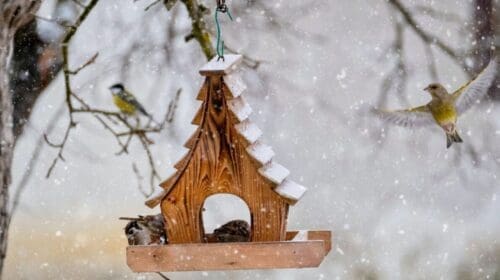Have you lifted a large pot of water? Heavy, isn’t it? Now, imagine many gallons of frozen rain and snow dammed at the bottom portion of your roof. As this bank of ice grows, it creates many problems for your roof, shingles and attic. But don’t worry, ice dams can be fixed!
Armour Shield Roofing strongly discourages homeowners from going up and down ladders or doing repairs on their roofs. The accidents and fatalities sustained by untrained individuals are tragic and avoidable by calling a professional roofing contractor.
What are the consequences of an accumulating hump of ice at the bottom edge of your roof?
- This barrier produced by frozen snow and ice prevents snow and rain from exiting correctly off your roof through the eaves and downspouts.
- The underside layer of melted ice has nowhere to go but down and toward the warm interior of your attic.
- Like the oncoming stream of water approaching a beaver dam of sticks and logs, falling snow has no way to pass the dam of ice and snow to exit your roof. The snow becomes an even bigger block of very heavy ice, putting incredible strain on your eavestroughs, downspouts, lower shingles and roofing plywood.
Armour Shield Roofing cares very much about your roof. We take care of eavestrough cleaning and inspect your roof to prevent or repair ice damming. Please contact us below.

What causes the phenomenon called ice damming?
Your warm attic air heats the underside of the roof plywood, and the heat transfers upward through to the shingles that have snow laying on them. The snow melts, but mother nature wins and refreezes the roof moisture, filling the eavestroughs and downspouts with solid ice.
The attic space transfers just enough heat to keep the lowest layer of ice melted, causing the plywood to rot and water to back up eventually under the shingles. The water turns to ice at night between the shingles, expands, and pushes the shingle layers apart. This cycle never corrects itself all winter and allows crevices between the shingles for water to leak down into the attic.
The shingle damage is evident in shingle edges drying, becoming brittle, losing granules, and eventually blown-off shingles.
Without repairing the overall problem, this cycle continues all winter, year after year.
What are the solutions to preventing ice dams before winter descends?
Your roof surface and attic space must remain at the same temperature. The upside to these remediations is less money is spent on your heating and cooling bills, which in turn rewards our environment.
You can achieve a neutral attic temperature in five ways:
1) Ventilate your roof to allow any warm attic air to escape.
Soffit vents, ridge vents, and roof vents should be part of your roof structure.
Soffit vents are on the underside of your soffit (where your eavestroughs are attached). They draw in the cooler, lower air from the outdoors, which pushes the warmer attic air out through your ridge vent (a vent that runs the entire length of your roof along its top ridge) and individual roof vents.
2) Seal your attic space from the heat of the lower floors of your home.
This means sealing the whole upper floor ceiling. Holes for lighting or venting must be well sealed with proper insulation, and recessed lighting must have air movement around their wired housing. Insulation and adequate taping around adequately sized individual boxes ensure the ventilation requirements for the lighting and the insulation requirements for the attic are met.
3) Ensure bathroom and laundry vents do not vent into your attic space.
All venting must go through walls or rigid venting that extends out of the top of the roof. Prevent the heat emanating from your vent pipe surfaces from transferring into your attic space by using foil-covered insulation sheathing made uniquely for this application.
4) All flashing must be correctly placed around the chimney, venting pipes, or skylights along with the use of their associated caulking.
The use of appropriate caulking, depending on the application of its use, whether for a chimney, skylight, or different flashing, is crucial with the use of flashing.
5) Add the correct amount of insulation to your attic.
Make sure the outside soffit edges are left free, so the movement of cool air coming from your soffits pushes the warm air up and out through your roof vents.
Armour Shield Roofing suggests these quick fixes if there is no other option for now. However, ice dams must be addressed professionally to avoid accumulated damage.
- Chloride-based icemelt products perform by drawing moisture from whatever they touch. However, this effect is highly damaging to living cells, whether skin, animal fur, insects, plants, shrubs, grasses, or trees.
- If allowed into waterways, these chloride-type products, although used in the past, have proved life-threatening to our fish and wildlife, reducing the oxygen in the water leading to extensive aquatic death.

Armour Shield Roofing strongly discourages homeowners from going up and down ladders or doing repairs on their roofs. The accidents and fatalities sustained by untrained individuals are tragic and avoidable by calling a professional roofing contractor.

